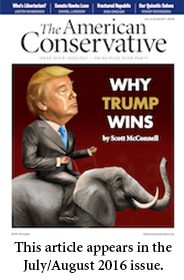Can a Moral Minority Survive?

On April 27, 1979, Jerry Falwell addressed thousands of conservative Christians from the steps of the Capitol. Asserting that the “vast majority” of Americans were opposed to pornography, abortion, and homosexuality, he announced the establishment of a new organization to promote “pro-family, pro-life, and pro-morality” policies. In a statement before the rally, Falwell explained the motive behind what he called the Moral Majority: “We’ve had enough and we want America cleaned up.”
Times have changed. Formerly confident in their numbers and clout, conservative Christians are now on the defensive. Falwell dreamed of cleaning up America. Nearly two generations later, his heirs are reduced to pleading for exemptions from sweeping anti-discrimination policies. Although popular with voters in some states, these pleas have not survived national scrutiny—even where Republicans hold power. In Indiana, a law that might have allowed bakers and photographers to decline service to gay weddings endured just a few months before it was “fixed” by the legislature. In Georgia, a similar bill was vetoed by the governor under intense pressure from big business.
The cultural transformation has been even more dramatic than the political one. Especially among highly educated people, beliefs that gender has a physiological basis or that procreation is a central purpose of marriage are proceeding from outré to unacceptable. In an ironic reversal, conservative Christians have adopted an idiom of concealment from a minority they once demonized: until recently, it was gays who spoke of being “in the closet.” Now they are joined by followers of traditional orthodoxy.
Mary Eberstadt is horrified by this development. In It’s Dangerous to Believe, she describes religious traditionalists as targets of a distinctly modern brand of intolerance that mirrors the history of religious fanaticism.
To support this interpretation, Eberstadt offers a parade of horribles drawn from around the English-speaking world. The incidents she cites range from the ouster of Brendan Eich as CEO of Mozilla to penalties imposed on teachers who defended Catholic doctrines on sexuality to the withdrawal of recognition from religious clubs at several universities. Eberstadt acknowledges that her examples are “disparate.” But she insists that they add up to a “widespread and growing effort to shame, punish, and ostracize people because of what they believe.”
There is nothing inherently novel about such campaigns, which have occurred with some frequency since the emergence of Biblical religion. What’s different is the issue at stake. This is not a dispute about the nature of God, proper form of worship, or correct rendering of revelation. Instead, “every act committed in the name of this new intolerance has a single, common denominator, which is the protection of the perceived prerogatives of the sexual revolution at all costs. The new intolerance is a wholly owned subsidiary of that revolution. No revolution, no new intolerance.”
Eberstadt offers a compelling analysis of the ideology that developed to justify the sexual revolution. Rather than a libertarian demand to leave people alone, it functions as an ersatz theology with its own its dogmas, theory of history, and canon of saints and martyrs. This parallel structure may be rooted in a process of secularization, as religious concepts were drained of their religious meaning. More likely, it reflects a basic human inclination to form systems, to make sense of the world.
Whatever its source, the internal coherence of moral progressivism explains the bitterness with which it responds to challenges. Critics of the new dispensation aren’t harmless dissenters. They are heretics whose denial of the truth threatens the possibility of a virtuous community.
In this respect, Eberstadt argues, the guardians of the sexual revolution can be understood as successors to the Puritans. Contrary to their reputation in some quarters as defenders of religious liberty, the Puritans were mostly interested in the freedom to do things their way. Error, concluded the divines of New England, had no rights. That is why they were so bitterly opposed to allowing members of other denominations to dwell among them.
When it came to Baptists and Catholics, this suspicion was not altogether irrational. But the Puritans’ fear of subversion did not stop with actual rivals. The logic of their theology turned them against adversaries that did not even exist. The witch trials were no aberration but a consequence of systematic intolerance.
Eberstadt contends that a similar logic is being turned against religious traditionalists today. The Moral Majority posed a plausible challenge to the sexual revolution. Today’s dissenters from the sexual revolution, by contrast, are symbolic sacrifices at the altar of progress. According to Eberstadt, “the notion that the religious counterculture” can enforce its vision of righteousness on a majority is “downright absurd.” In her judgment, it is because they have so little real influence that recalcitrant bakers or photographers have to be publicly shamed by progressives.
Eberstadt’s description of the bewildered faithful, caught up in rapid social change, is deeply affecting. She is an acute critic of the way some Christian institutions have distanced themselves from their own teachings at the expense of low-level employees, who didn’t get the memo about what’s now politically acceptable in time. Eberstadt also discusses shocking incidents in which the mere expression of religious beliefs has led to denial of educational and job opportunities. This is prejudice pure and simple. One hopes liberals and progressives will accept her call to reject it—particularly in institutions of higher learning whose leaders speak ceaselessly of their commitment to diversity.
Yet many of the cases Eberstadt discusses are more complicated than the Manichean struggle she depicts. More than attacks on unpopular ideas, they are disputes about the discharge of political office or participation in government programs.
Take the hapless Kim Davis, who refused to issue marriage licenses to same-sex couples in Rowan County, Ky. What provoked Davis’s more thoughtful critics was not the refusal in itself. Instead, it was her expectation that she could reject the Supreme Court’s decision in Obergefell v. Hodges while keeping her job. This was not the conventional understanding of conscientious objection that allows believers to avoid otherwise compulsory duties—most prominently, military service. Instead, it looked like an attempt by a sworn public servant to have it both ways by choosing which responsibilities of her office she was willing to discharge.
After several months of wrangling, the state of Kentucky reached a compromise that removes county clerks’ names from the marriage licenses they issue. This seems a reasonable policy that protects the rights and dignity of all involved. It was necessary, however, because the connection between traditional religious belief and civil authority is not as dead as Eberstadt suggests.
The challenges to the Obamacare contraception mandate recently argued before the Supreme Court also defy Eberstadt’s depiction of a war on traditional belief. Rather than targets of an “ideological power play,” for-profit corporations such as Hobby Lobby and religious institutions like the Little Sisters of the Poor were collateral damage of a massive expansion of the administrative state. The underlying problem here is not the pseudo-theology of the sexual revolution but the cooptation of private enterprises and associations to supply a public benefit.
Eberstadt is too quick to attribute controversies about the political role of religion to irrational animus on the part of progressives. She also tends to reduce religion to Christianity and Christianity to its more traditionalist currents. This reduction makes it easier to treat religious belief as such as the target of hostility from a monolithic secular consensus.
But the American religious scene is more varied than Eberstadt acknowledges. In addition to the conservative Christians on whom she focuses, many believers have made their peace with the sexual revolution and the world it has made—or at least figured out how to live alongside it. That includes American Jews, including many who hold politically incorrect views on sexuality.
Why do Jews escape the opprobrium to which traditionalist Catholics or Baptists are subjected? Partly because they have never been more than a tiny minority, but also because they make few claims on political and cultural authority. Apart from a few neighborhoods in and around New York City, no one fears that religious Jews will attempt to dictate how they live their own lives. As a result, they are able to avoid most forms of interference with their communities.
 There is a lesson here for the Christian traditionalists for whom Eberstadt speaks. They are more likely to win space to live according to their consciences to the extent that they are able to convince a majority that includes more liberal Christians and non-Christian believers, as well as outright secularists, that they are not simply biding their time until they are able to storm the public square. In addition, they will have to develop institutions of community life that are relatively low-visibility and that can survive without many forms of official support. The price of inclusion in an increasingly pluralistic society may be some degree of voluntary exclusion from the dominant culture.
There is a lesson here for the Christian traditionalists for whom Eberstadt speaks. They are more likely to win space to live according to their consciences to the extent that they are able to convince a majority that includes more liberal Christians and non-Christian believers, as well as outright secularists, that they are not simply biding their time until they are able to storm the public square. In addition, they will have to develop institutions of community life that are relatively low-visibility and that can survive without many forms of official support. The price of inclusion in an increasingly pluralistic society may be some degree of voluntary exclusion from the dominant culture.
There is no doubt that this will be a hard bargain for adherents of traditions that enjoyed such immense authority until recently. As Eberstadt points out, however, it will also be difficult for progressives who resemble Falwell in their moral majoritarianism. The basis for coexistence must be a shared understanding that the Christian America for which some long and that others fear isn’t coming back—not only because it was Christian but also because it involved a level of consensus that is no longer available to us. There are opportunities for believers and nonbelievers alike in this absence.
Samuel Goldman is an assistant professor of political science and director of the Loeb Institute for Religious Freedom at George Washington University.